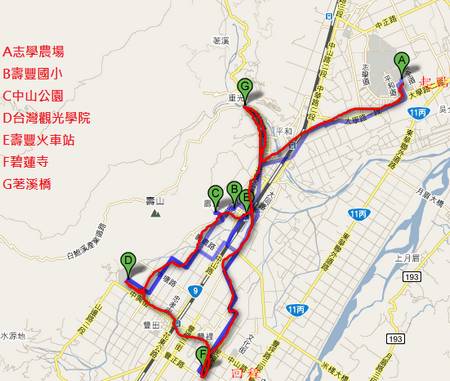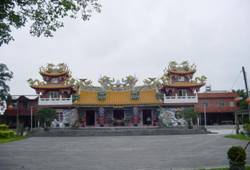Middle Lines
Shou-Feng Line
Hao Xiang

(he Starting Point) Second intersection take the right after the Mugua River Bridge on the south bound of the No.9 Highway-->turn left and reach the Hua County Road No.33 toward the south-->Chi Hsue Farm-->The intersection of Pinghe St. and Pinghe 2nd St. in Pinghe Village-->Pinghe 2nd St.-->Turn right at the intersection in front of Pinghe Elementary School-->Turn left at Kuangrong Bridge-->Kuangrong 5th St.-->Turn left at Chungshan Rd. (No.9 Bing Hwy.)-->No.9 Hwy.-->Pass Chunghwa Rd then take the right turn-->Turn left at Shanbian Rd.-->Shoufeng Elementary School-->Chunshan Park-->Shanbian Rd.-->When it comes to the intersection of three roads, take the left (red line) towards south and pass Shuhu Community-->Taiwan Incense-cedar Forest; take the right (pink line) and pass Taiwan Hospitality & Tourism College-->Taiwan Incense-cedar Forest-->Sikou 3rd St.-->At the end of the street take the left and pass No.9 Hwy.-->Jen'ai St.-->Bilian Temple-->Konghe Rd.-->Hsialaosi Bridge-->No.9 Hwy. (The final point)
Introduction of the Journey:
The bikeway lengths approximately 26km, starting at Heping Village at the bottom of Liyu Mountain. The sceneries along the journey are beautiful. Before arriving Sikou Village, you will see the huge Taiwan Incense-cedar Forest. The Taiwan Incense-cedar is one of the top five conifers in Taiwan, only grows in Taiwan. They look very elegant. Continue towards the east and pass the No.9 Hwy., the view changes in a sudden. Toward the north, you will see Bilian Temple which was previously a Japanese shrine, and Fengtian Village which where the Japanese immigrants settled. The remained bird nests, the rock lantern, and the old houses, all are telling the history of vicissitudes.
ntroduction of the Scenic Spots:
 Bilian Temple
Bilian Temple
Bilian Temple was previously a Japanese shrine. It was named Bilian in 1947, worships Gautama Buddha, Acala, Guanyin, Maitreya, Nuwa, Mazu, and Shennong. Next to the temple you can find the elderly club, gateball court, tennis court, play ground etc. Therefore, Bilian Temple is not the center of religion, but also an essential part of the locals' daily life.
